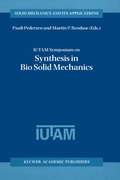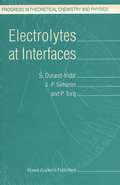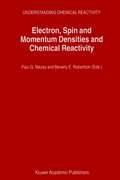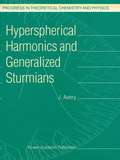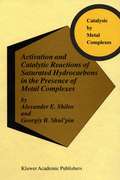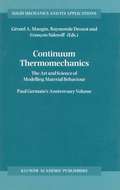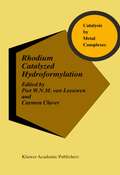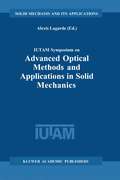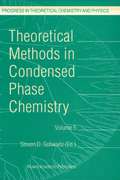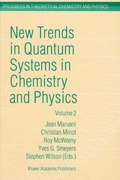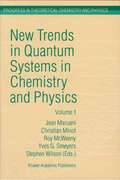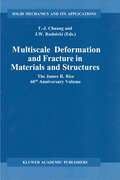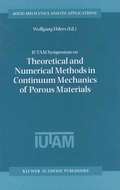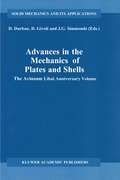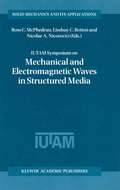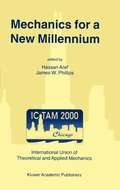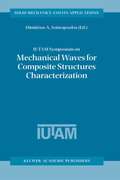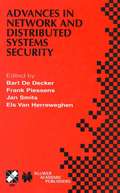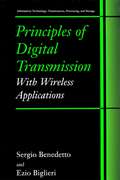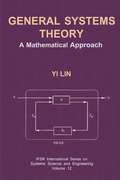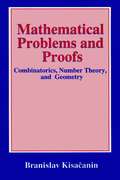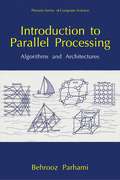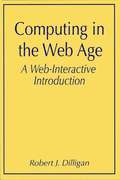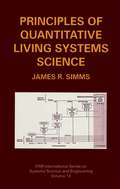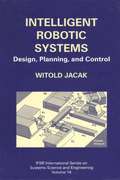- Table View
- List View
IUTAM Symposium on Synthesis in Bio Solid Mechanics: Proceedings of the IUTAM Symposium held in Copenhagen, Denmark, 24–27 May 1998 (Solid Mechanics and Its Applications #69)
by Pauli Pedersen Martin P. BendsøeThis book contains the edited version of invited lectures presented at the IUTAM-Sym- sium Synthesis in Bio Solid Mechanics, held at Hotel Frederiksdal, Virum (Copenhagen), Denmark, May 24 to May 27, 1998. The symposium was attended by 48 scientist from 14 countries. Biomechanics has been a very active research area in the last 25 years and covers a very broad class of problems. The present symposium concentrated on the solid mechanics - main of biomechanics, where important problems of synthesis presently are an active and challenging part. Characteristics of biomechanical materials are not only the inhomogeneity and anisotropy, but also the capability to change in relation to actual use. These living materials call for new methods of analysis and also new methods for synthesis. By the synthesis in this context is meant design of implants or artificial control of material growth. Bone mechanics is closely related to recent work on analysis and design of microstructural anisotropic materials. Also, recent work in shape design can to some extent be useful in the more complicated problems of biomechanics. Here interface problems play an essential role. The symposium brought together scientists from mechanics, mathematics and medicine.
Electrolytes at Interfaces (Progress in Theoretical Chemistry and Physics #1)
by S. Durand-Vidal J.-P. Simonin P. TurqThe aim of this book is to provide the reader with a modern presentation of ionic solutions at interfaces, for physical chemists, chemists and theoretically oriented experimentalists in this field. The discussion is mainly on the structural and thermodynamic properties, in relation to presently available statistical mechanical models. Some dynamic properties are also presented, at a more phenomenological level. The initial chapters are devoted to the presentation of some basic concepts for bulk properties: hydrodynamic interactions, electrostatics, van der Waals forces and thermodynamics of ionic solutions in the framework of a particular model: the mean spherical approximation (MSA). Specific features of interfaces are then discussed: experimental techniques such as in-situ X-ray diffraction, STM and AFM microscopy are described. Ions at liquid/air, liquid/metal and liquid/liquid interfaces are considered from the experimental and theoretical viewpoint. Lastly some dynamic (transport) properties are included, namely the self-diffusion and conductance of small colloids (polyelectrolytes and micelles) and the kinetics of solute transfer at free liquid/liquid interfaces.
Electron, Spin and Momentum Densities and Chemical Reactivity (Understanding Chemical Reactivity #21)
by Paul G. Mezey Beverly E. RobertsonThe electron density of a non-degenerate ground state system determines essentially all physical properties of the system. This statement of the Hohenberg–Kohn theorem of Density Functional Theory plays an exceptionally important role among all the fundamental relations of Molecular Physics. In particular, the electron density distribution and the dynamic properties of this density determine both the local and global reactivities of molecules. High resolution experimental electron densities are increasingly becoming available for more and more molecules, including macromolecules such as proteins. Furthermore, many of the early difficulties with the determination of electron densities in the vicinity of light nuclei have been overcome. These electron densities provide detailed information that gives important insight into the fundamentals of molecular structure and a better understanding of chemical reactions. The results of electron density analysis are used in a variety of applied fields, such as pharmaceutical drug discovery and biotechnology. If the functional form of a molecular electron density is known, then various molecular properties affecting reactivity can be determined by quantum chemical computational techniques or alternative approximate methods.
Hyperspherical Harmonics and Generalized Sturmians (Progress in Theoretical Chemistry and Physics #4)
by John S. AveryActivation and Catalytic Reactions of Saturated Hydrocarbons in the Presence of Metal Complexes (Catalysis by Metal Complexes #21)
by A.E. Shilov Georgiy B. Shul'pinhemistry is the science about breaking and forming of bonds between atoms. One of the most important processes for organic chemistry is breaking bonds C–H, as well as C–C in various compounds, and primarily, in hydrocarbons. Among hydrocarbons, saturated hydrocarbons, alkanes (methane, ethane, propane, hexane etc. ), are especially attractive as substrates for chemical transformations. This is because, on the one hand, alkanes are the main constituents of oil and natural gas, and consequently are the principal feedstocks for chemical industry. On the other hand, these substances are known to be the less reactive organic compounds. Saturated hydrocarbons may be called the “noble gases of organic chemistry” and, if so, the first representative of their family – methane – may be compared with extremely inert helium. As in all comparisons, this parallel between noble gases and alkanes is not fully accurate. Indeed the transformations of alkanes, including methane, have been known for a long time. These reactions involve the interaction with molecular oxygen from air (burning – the main source of energy!), as well as some mutual interconversions of saturated and unsaturated hydrocarbons. However, all these transformations occur at elevated temperatures (higher than 300–500 °C) and are usually characterized by a lack of selectivity. The conversion of alkanes into carbon dioxide and water during burning is an extremely valuable process – but not from a chemist viewpoint.
Continuum Thermomechanics: The Art and Science of Modelling Material Behaviour (Solid Mechanics and Its Applications #76)
by Gérard A. MauginContributed by world-renowned specialists on the occasion of Paul Germain's 80th birthday, this unique book reflects the foundational works and the intellectual influence of this author. It presents the realm of modern thermomechanics with its extraordinary wealth of applications to the behaviour of materials, whether solid or fluid. The thirty-one contributions follow an easygoing autobiographical sketch by Paul Germain, and highlight the power and richness of a methodological approach to the phenomenology of many materials. This approach combines harmoniously thermodynamics and continuum theory in order to provide exploitable, thermodynamically admissible models of a large variety of behaviours and phenomena, including those of diffusion, thermoelasticity, viscoplasticity, relaxation, hysteresis, wetting, shape-memory effects, growth, phase transitions, stability, fracture, shocks, machining of materials, microstructured solids, complex fluids, etc. Especially aimed at graduate students, researchers, and engineers in mechanical engineering and materials science, this book also presents the state of the art in an active field of research and opens new horizons in other scientific fields, such as applied mathematics and applied physics, because of the intellectual satisfaction and remarkable efficiency provided by the advocated approach.
Rhodium Catalyzed Hydroformylation (Catalysis by Metal Complexes #22)
by Piet W. N. M. Van Leeuwen Carmen ClaverIn the last decade there have been numerous advances in the area of rhodium-catalyzed hydroformylation, such as highly selective catalysts of industrial importance, new insights into mechanisms of the reaction, very selective asymmetric catalysts, in situ characterization and application to organic synthesis. The views on hydroformylation which still prevail in the current textbooks have become obsolete in several respects. Therefore, it was felt timely to collect these advances in a book. The book contains a series of chapters discussing several rhodium systems arranged according to ligand type, including asymmetric ligands, a chapter on applications in organic chemistry, a chapter on modern processes and separations, and a chapter on catalyst preparation and laboratory techniques. This book concentrates on highlights, rather than a concise review mentioning all articles in just one line. The book aims at an audience of advanced students, experts in the field, and scientists from related fields. The didactic approach also makes it useful as a guide for an advanced course.
IUTAM Symposium on Advanced Optical Methods and Applications in Solid Mechanics: Proceedings of the IUTAM Symposium held in Futuroscope, Poitiers, France, August 31st–September 4th, 1998 (Solid Mechanics and Its Applications #82)
by Alexis LagardeThe request to organize under its patronage at Poitiers in 1998 a Symposium entitled “Advanced Optical Methods and Applications in Solid Mechanics” by the International Union of Theoretical and Applied Mechanics (I.U.T.A.M.) was well received for the following two reasons. First, for nearly 20 years no Symposium devoted to optical methods in solids had been organized. Second, recent advances in digital image processing provided many new applications which are described in the following. We have the honour to present here the proceedings of this Symposium. st th The Symposium took place from august 31 to September 4 at the Institut International de la Prospective in Futuroscope near Poitiers. A significant number of internationally renowned specialists had expressed their wish to participate in this meeting. The Scientific Committee proposed 16 general conferences and selected 33 regular lectures and 17 poster presentations. Papers corresponding to posters are not differentiated in the proceedings from those that were presented orally. It is worth noting that a total of 80 participants, representing 16 countries, registered for this symposium.. The Scientific Committee deserves praise for attracting a significant number of young scientists, both as authors and as participants. Let us add our warm acknowledgements to Professor J.W. Dally and to Professor A.S. Kobayashi who, throughout the symposium preparation time, brought us valuable help.
Theoretical Methods in Condensed Phase Chemistry (Progress in Theoretical Chemistry and Physics #5)
by S. D. SchwartzThis book is meant to provide a window on the rapidly growing body of theoretical studies of condensed phase chemistry. A brief perusal of physical chemistry journals in the early to mid 1980’s will find a large number of theor- ical papers devoted to 3-body gas phase chemical reaction dynamics. The recent history of theoretical chemistry has seen an explosion of progress in the devel- ment of methods to study similar properties of systems with Avogadro’s number of particles. While the physical properties of condensed phase systems have long been principle targets of statistical mechanics, microscopic dynamic theories that start from detailed interaction potentials and build to first principles predictions of properties are now maturing at an extraordinary rate. The techniques in use range from classical studies of new Generalized Langevin Equations, semicl- sical studies for non-adiabatic chemical reactions in condensed phase, mixed quantum classical studies of biological systems, to fully quantum studies of m- els of condensed phase environments. These techniques have become sufficiently sophisticated, that theoretical prediction of behavior in actual condensed phase environments is now possible. and in some cases, theory is driving development in experiment. The authors and chapters in this book have been chosen to represent a wide variety in the current approaches to the theoretical chemistry of condensed phase systems. I have attempted a number of groupings of the chapters, but the - versity of the work always seems to frustrate entirely consistent grouping.
New Trends in Quantum Systems in Chemistry and Physics: Volume 2 Advanced Problems and Complex Systems Paris, France, 1999 (Progress in Theoretical Chemistry and Physics #7)
by R. McWeeny Christian Minot Y. G. Smeyers Stephen Wilson J. MaruaniThese two volumes collect thirty-eight selected papers from the scientific contributions presented at the Fourth European Workshop on Quantum Systems in Chemistry and Physics (QSCP-IV), held in Marly-le-Roi (France) in April 22-27, 1999. A total of one hundred and fifteen scientists attended the workshop, 99 from Europe and 16 from the rest of the world. They discussed the state of the art, new trends, and future evolution of the methods and applications. The workshop was held in the old town of Marly-le-Roi, which lies to the West of Paris between the historic centres of Saint-Germain-en-Laye and Versailles. Participants were housed at the National Youth Institute, where over sixty lectures were given by l- ding members of the scientific community; in addition, over sixty posters were presented in two very animated sessions. We are grateful to the oral speakers and to the poster p- senters for making the workshop such an stimulating experience. The social programme was also memorable – and not just for the closing banquet, which was held at the French Senate House. We are sure that participants will long remember their visit to the 'Musée des Antiquités Nationales': created by Napoleon III at the birthplace of Louis XIV, this museum boasts one of the world finest collections of archeological artifacts. The Marly-le-Roi workshop followed the format established at the three previous meetings, organized by Prof.
New Trends in Quantum Systems in Chemistry and Physics: Volume 1 Basic Problems and Model Systems Paris, France, 1999 (Progress in Theoretical Chemistry and Physics #6)
by R. McWeeny Christian Minot Y. G. Smeyers Stephen Wilson J. MaruaniThese two volumes collect thirty-eight selected papers from the scientific contributions presented at the Fourth European Workshop on Quantum Systems in Chemistry and Physics (QSCP-IV), held in Marly-le-Roi (France) in April 22-27, 1999, A total ofone hundred and fifteen scientists attended the workshop, 99 from Europe and 16 from the rest ofthe world. They discussed the state of the art, new trends, and future evolution of the methods and applications. The workshop was held in the old town of Marly-le-Roi, which lies to the West of Paris between the historic centres of Saint-Germain-en-Laye and Versailles. Participants were housed at the National Youth Institute, where over sixty lectures were given by l- ding members ofthe scientific community; in addition, over sixty posters were presented in two very animated sessions. We are grateful to the oral speakers and to the poster p- senters for making the workshop such an stimulating experience. The social programme was also memorable - and notjust for the closing banquet, which was held at the French Senate House. We are sure that participants will long remember their visit to the 'Musée des Antiquités Nationales': created by Napoleon III at the birthplace ofLouis XIV, this museum boasts one ofthe world finest collections ofarcheological artifacts. The Marly-le-Roi workshop followed the format established at the three previous meetings, organized by Prof.
Multiscale Deformation and Fracture in Materials and Structures: The James R. Rice 60th Anniversary Volume (Solid Mechanics and Its Applications #84)
by T. J. Chuang J. W. RudnickiModern Solid Mechanics considers phenomena at many levels, ranging from nano size at atomic scale through the continuum level at millimeter size to large structures at the tens of meter scale. The deformation and fracture behavior at these various scales are inextricably related to interdisciplinary methods derived from applied mathematics, physics, chemistry, and engineering mechanics. This book, in honor of James R. Rice, contains articles from his colleagues and former students that bring these sophisticated methods to bear on a wide range of problems. Articles discussing problems of deformation include topics of dislocation mechanics, second particle effects, plastic yield criterion on porous materials, hydrogen embrittlement, solid state sintering, nanophases at surfaces, adhesion and contact mechanics, diffuse instability in geomaterials, and percolation in metal deformation. In the fracture area, the topics include: elastic-plastic crack growth, dynamic fracture, stress intensity and J-integral analysis, stress-corrosion cracking, and fracture in single crystal, piezoelectric, composite and cementitious materials. The book will be a valuable resource for researchers in modern solid mechanics and can be used as reference or supplementary text in mechanical and civil engineering, applied mechanics, materials science, and engineering graduate courses on fracture mechanics, elasticity, plasticity, mechanics of materials or the application of solid mechanics to processing, and reliability of life predictions.
IUTAM Symposium on Theoretical and Numerical Methods in Continuum Mechanics of Porous Materials: Proceedings of the IUTAM Symposium held at the University of Stuttgart, Germany, September 5–10, 1999 (Solid Mechanics and Its Applications #87)
by Wolfgang EhlersDuring the last decades, continuum mechanics of porous materials has achieved great attention, since it allows for the consideration of the volumetrically coupled behaviour of the solid matrix deformation and the pore-fluid flow. Naturally, applications of porous media models range from civil and environmental engineering, where, e. g. , geote- nical problems like the consolidation problem are of great interest, via mechanical engineering, where, e. g. , the description of sinter materials or polymeric and metallic foams is a typical problem, to chemical and biomechanical engineering, where, e. g. , the complex structure of l- ing tissues is studied. Although these applications are principally very different, they basically fall into the category of multiphase materials, which can be described, on the macroscale, within the framework of the well-founded Theory of Porous Media (TPM). With the increasing power of computer hardware together with the rapidly decreasing computational costs, numerical solutions of complex coupled problems became possible and have been seriously investigated. However, since the quality of the numerical solutions strongly depends on the quality of the underlying physical model together with the experimental and mathematical possibilities to successfully determine realistic material parameters, a successful treatment of porous materials requires a joint consideration of continuum mechanics, experimental mechanics and numerical methods. In addition, micromechanical - vestigations and homogenization techniques are very helpful to increase the phenomenological understanding of such media.
Advances in the Mechanics of Plates and Shells: The Avinoam Libai Anniversary Volume (Solid Mechanics and Its Applications #88)
by D. Durban Dan Givoli J. G. SimmondsThe optimal control of flexible structures is an active area of research. The main body of work in this area is concerned with the control of time-dependent displacements and stresses, and assumes linear elastic conditions, namely linear elastic material behavior and small defor- tion. See, e. g. , [1]–[3], the collections of papers [4, 5], and references therein. On the other hand, in the present paper we consider the static optimal control of a structure made of a nonlinear elastic material and und- going large deformation. An important application is the suppression of static or quasi-static elastic deformation in flexible space structures such as parts of satellites by the use of control loads [6]. Solar rad- tion and radiation from other sources induce a temperature field in the structure, which in turn generates an elastic displacement field. The displacements must usually satisfy certain limitations dictated by the allowed working conditions of various orientation-sensitive instruments and antennas in the space vehicle. For example, a parabolic reflector may cease to be effective when undergoing large deflection. The elastic deformation can be reduced by use of control loads, which may be imp- mented via mechanically-based actuators or more modern piezoelectric devices. When the structure under consideration is made of a rubb- like material and is undergoing large deformation, nonlinear material and geometric effects must be taken into account in the analysis.
IUTAM Symposium on Mechanical and Electromagnetic Waves in Structured Media: Proceedings of the IUTAM Symposium held in Sydney, NSW, Australia, 18–22 January 1999 (Solid Mechanics and Its Applications #91)
by Ross C. McPhedran Lindsay C. Botten Nicolae-A. P. NicoroviciThe IUTAM Symposium on Mechanical and Electromagnetic Waves in Structured Media took place at the University of Sydney from January 18- 22, 1999. It brought together leading researchers from eleven countries for a week-long meeting, with the aim of providing cross-links between the com- nities studying related problems involving elastic and electromagnetic waves in structured materials. After the meeting, participants were invited to submit articles based on their presentations, which were refereed and assembled to constitute these Proceedings. The topics covered here represent areas at the forefront of research intoelastic and electromagnetic waves. They include effect of nonlinearity, diffusion and multiple scattering on waves, as well as asymptotic and numerical techniques. Composite materials are discussed in depth, with example systems ranging fromdusty plasmas to a magneto-elastic microstructured system. Also included are studies of homogenisation, that field which seeks to determine equivalent homogeneous systems which can give equivalent wave properties to structured materials, and inverse problems, in which waves are used as a probe to infer structural details concerning scattering systems. There are also strong groups of papers on the localization of waves by random systems, and photonic and phononic band gap materials. These are being developed by analogue with semiconductors for electrons, and hold out the promise of enabling designers to control the propagation of waves through materials in novel ways. We would like to thank the other members of the Scientific Committee (A.
Mechanics for a New Millennium: Proceedings of the 20th International Congress on Theoretical and Applied Mechanics, held in Chicago, USA, 27 August – 2 September 2000
by Hassan Aref James W. PhillipsThis volume contains the proceedings of the 2000 International Congress of Theoretical and Applied Mechanics. The book captures a snapshot view of the state of the art in the field of mechanics and will be invaluable to engineers and scientists from a variety of disciplines.
IUTAM Symposium on Mechanical Waves for Composite Structures Characterization: Proceedings of the IUTAM Symposium held in Chania, Crete, Greece, June 14–17, 2000 (Solid Mechanics and Its Applications #92)
by Dimitrios A. SotiropoulosThis book is a collection of selected reviewed papers that were presented at the International Union of Theoretical and Applied Mechanics Symposium "Mechanical waves for composite structures characterization". The Symposium took place June 14-17, 2000 in Chania, Crete, Greece. As is customary, IUTAM Symposia Proceedings are published in the series "Solid Mechanics and Its Applications" by Kluwer Academic Publishers. I am indebted to Professor G. M. L. Gladwell who is the series editor. I would also like to take this opportunity to express my sincere gratitude to Professor M. A. Hayes the Secretary General of the International Union of Theoretical and Applied Mechanics and a member ofthe Symposium's Scientific Committee. His constant encouragement and support made the Symposium not only possible but also successful. To the success also contributed all the members of the Symposium's Scientific Committee which I had the honor to chair. I express my appreciation to each one of them who are: Professor J. D. Achenbach (Northwestern University, Evanston, Illinois, USA), Professor M. A. Hayes (University College, Dublin, Ireland), Professor K. J. Langenberg (University of Kassel, Germany), Professor A. K. Mal (University of California, Los Angeles, USA), Professor X. Markenscoff (University of California, San Diego, USA), Professor S. Nair (Illinois Institute of Technology, Chicago, USA), Professor R. W. Ogden (University of Glasgow, UK), Professor G.
Advances in Network and Distributed Systems Security: IFIP TC11 WG11.4 First Annual Working Conference on Network Security November 26–27, 2001, Leuven, Belgium (IFIP Advances in Information and Communication Technology #78)
by Els Van Herreweghen Frank Piessens Jan Smits Bart De DeckerPrinciples of Digital Transmission: With Wireless Applications (Information Technology: Transmission, Processing and Storage)
by Sergio Benedetto Ezio BiglieriPrinciples of Digital Transmission is designed for advanced undergraduate and graduate level students and professions in telecommunications. Teachers and learners can mix and match chapters to create four distinct courses: (1) a one-term basic course in digital communications; (2) a one-term course in advanced digital communications; (3) a one-term course in information theory and coding; (4) a two-term course sequence in digital communications and coding. The book provides rigorous mathematical tools for the analysis and design of digital transmission systems. The authors emphasize methodology in their aim to teach the reader how to do it rather than how it is done. They apply the fundamental tools of the discipline onto a number of systems, such as wireless data transmission systems.
General Systems Theory: A Mathematical Approach (IFSR International Series in Systems Science and Systems Engineering #12)
by Yi LinAs suggested by the title of this book, I will present a collection of coherently related applications and a theoretical development of a general systems theory. Hopefully, this book will invite all readers to sample an exciting and challenging (even fun!) piece of interdisciplinary research, that has characterized the scientific and technological achievements of the twentieth century. And, I hope that many of them will be motivated to do additional reading and to contribute to topics along the lines described in the following pages. Since the applications in this volume range through many scientific disciplines, from sociology to atomic physics, from Einstein’s relativity theory to Dirac’s quan tum mechanics, from optimization theory to unreasonable effectiveness of mathe matics to foundations of mathematical modeling, from general systems theory to Schwartz’s distributions, special care has been given to write each application in a language appropriate to that field. That is, mathematical symbols and abstractions are used at different levels so that readers in various fields will find it possible to read. Also, because of the wide range of applications, each chapter has been written so that, in general, there is no need to reference a different chapter in order to understand a specific application. At the same time, if a reader has the desire to go through the entire book without skipping any chapter, it is strongly suggested to refer back to Chapters 2 and 3 as often as possible.
Mathematical Problems and Proofs: Combinatorics, Number Theory, and Geometry
by Branislav KisacaninA gentle introduction to the highly sophisticated world of discrete mathematics, Mathematical Problems and Proofs presents topics ranging from elementary definitions and theorems to advanced topics -- such as cardinal numbers, generating functions, properties of Fibonacci numbers, and Euclidean algorithm. This excellent primer illustrates more than 150 solutions and proofs, thoroughly explained in clear language. The generous historical references and anecdotes interspersed throughout the text create interesting intermissions that will fuel readers' eagerness to inquire further about the topics and some of our greatest mathematicians. The author guides readers through the process of solving enigmatic proofs and problems, and assists them in making the transition from problem solving to theorem proving. At once a requisite text and an enjoyable read, Mathematical Problems and Proofs is an excellent entrée to discrete mathematics for advanced students interested in mathematics, engineering, and science.
Introduction to Parallel Processing: Algorithms and Architectures (Series in Computer Science)
by Behrooz ParhamiTHE CONTEXT OF PARALLEL PROCESSING The field of digital computer architecture has grown explosively in the past two decades. Through a steady stream of experimental research, tool-building efforts, and theoretical studies, the design of an instruction-set architecture, once considered an art, has been transformed into one of the most quantitative branches of computer technology. At the same time, better understanding of various forms of concurrency, from standard pipelining to massive parallelism, and invention of architectural structures to support a reasonably efficient and user-friendly programming model for such systems, has allowed hardware performance to continue its exponential growth. This trend is expected to continue in the near future. This explosive growth, linked with the expectation that performance will continue its exponential rise with each new generation of hardware and that (in stark contrast to software) computer hardware will function correctly as soon as it comes off the assembly line, has its down side. It has led to unprecedented hardware complexity and almost intolerable dev- opment costs. The challenge facing current and future computer designers is to institute simplicity where we now have complexity; to use fundamental theories being developed in this area to gain performance and ease-of-use benefits from simpler circuits; to understand the interplay between technological capabilities and limitations, on the one hand, and design decisions based on user and application requirements on the other.
Computing in the Web Age: A Web-Interactive Introduction
by Robert J. DilliganThis book reflects thirty years of experience in the applications of computer technology to literary research and instruction and in consulting work in office automation and system integration. In that time I have again and again found myself in the position of having to introduce students, both undergraduate and graduate, colleagues and clients to the fundamentals of computer hardware and software. Over the years, as computers became both central and commonplace in professional life, I have been aware of changing attitudes toward this technology. From attitudes that ranged from the disdain of platonic dialecticians for mere technology to intimidation bordering at times almost on terror, people have moved to incorporate this new technology into their frame of reference ( humani nil a me alienum ). The development of the microprocessor and its subsequent use for word processing marked one important watershed. The widespread use of word processors made it more likely than not that people would own their own computers, at least at work, and use them as part of their work-a-day activities. But while word processing provided some increased familiarity with computers, it did not lead most indivi- als much beyond a knowledge of the usual incantations needed to control the MultiMate or Nota Bene or Word Perfect golam and, as a result of unhappy experience, a begrudging acceptance of the need to make back up copies of important files.
Principles of Quantitative Living Systems Science (IFSR International Series in Systems Science and Systems Engineering #13)
by James R. SimmsIn 1978, when the book Living Systems was published, it contained the prediction that the sciences that were concerned with the biological and social sciences would, in the future, be stated as rigorously as the “hard sciences” that study such nonliving phenomena as temperature, distance, and the interaction of chemical elements. Principles of Quantitative Living Systems Science, the first of a planned series of three books, begins an attempt to fulfill that prediction. The view that living things are similar to other parts of the physical world, differing only in their complexity, was explicitly stated in the early years of the twentieth century by the biologist Ludwig von Bertalanffy. His ideas could not be published until the end of the war in Europe in the 1940s. Von Bertalanffy was strongly opposed to vitalism, the theory current among biologists at the time that life could only be explained by recourse to a “vital principle” or God. He c- sidered living things to be a part of the natural order, “systems” like atoms and molecules and planetary systems. Systems were described as being made up of a number of interrelated and interdependent parts, but because of the interrelations, the total system became more than the sum of those parts. These ideas led to the development of systems movements, in both Europe and the United States, that included not only biologists but scientists in other fields as well. Systems societies were formed on both continents.
Intelligent Robotic Systems: Design, Planning, and Control (IFSR International Series in Systems Science and Systems Engineering #14)
by Witold JacakHere is a comprehensive presentation of methodology for the design and synthesis of an intelligent complex robotic system, connecting formal tools from discrete system theory, artificial intelligence, neural network, and fuzzy logic. The necessary methods for solving real time action planning, coordination and control problems are described. A notable chapter presents a new approach to intelligent robotic agent control acting in a realworld environment based on a lifelong learning approach combining cognitive and reactive capabilities. Another key feature is the homogeneous description of all solutions and methods based on system theory formalism.
